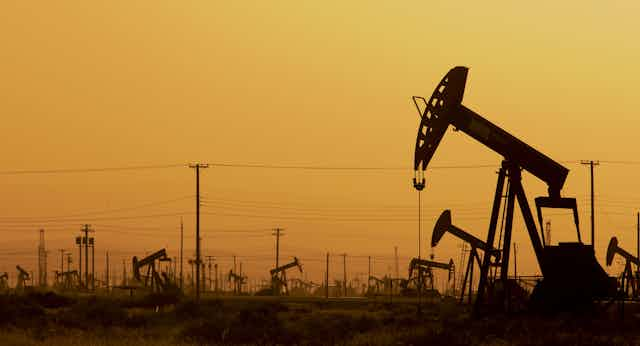President-elect Donald Trump has a “vision” for an “America first energy plan”. This includes developing new oil fields in the US, creating “at least half a million new jobs” in energy, and promoting natural gas over coal in order to tackle emissions.
Also on the list are making “America energy independent” and the aim for it to be “totally independent of any need to import energy from the OPEC cartel or any nations hostile to our interest”. Removing US demand from the global energy market would have a huge knock-on effect across the world. But it’s not actually clear whether Trump will be able to achieve his goal – or if he’d even want to.
The US is already increasingly able to produce its own energy. In 2013 it surpassed Saudi Arabia and Russia to become the world’s largest producer of petroleum products, and only around a quarter of its oil is now imported – the lowest figure since 1970. This compares favourably to the UK (42% imported), and the EU (nearly 88%).
Trump’s fears, though, are nothing new: consecutive US administrations have worried about the country’s dependence on imported oil. During the 1970s, falling domestic output and the Arab oil embargo led to government-funded research that fostered the development of fracking. Along with other recent technologies, fracking partly explains why production is at its highest level in decades.
The US now imports crude oil and petroleum products from 88 different countries, but Trump was explicit in wanting to stop importing oil from Opec – the 14 member cartel set up in 1960. The group is able to exercise control on global oil prices and supplies as it produces around 57% of oil exports and collectively it holds 81% of proven oil reserves.
Around 31% of US imports come from Opec, mostly Saudi Arabia and Venezuela. Canada (40% alone) and Mexico (8%) are the other biggest sources of US imports, but neither are members of Opec. Additionally, Opec supply only accounts for 15% of US daily consumption. Over the past decade, imports from Opec have fallen each year, and in 2015 they were at their lowest since 1987.
So the “Opec dependency”, as perceived by Trump and others, turns out to be relatively minor. But this is where energy and foreign policy cross paths.

America’s complicated relationship with Saudi Arabia has its roots in geopolitics and nearly a century of foreign policy. The US began investing in the region’s oil during the 1920s in response to falling domestic output, and ever since its foreign policy has been partly determined by its dependence on oil imports from other countries. Saudi Arabia has been a key ally of the US in the Middle East, and it is unclear how far Trump will go in realigning the nature of American engagement with the country.
With such low relative imports from Opec it could be assumed that ending imports from them would be simple; however the type of oil they supply is equally important. Most US-produced oil is known as “sweet” crude, because of its low sulphur content and density. But countries such as Saudi Arabia and Venezuela produce “sour” crude. Sweet crude is less energy intensive but cheaper and easier to refine. However, much of the oil refinery capacity in the US – notably on the Gulf coast – is designed to process sour and heavy oil because of the historic import dependency.
But the US could further increase imports of Canadian crude oil. In 2015 President Obama vetoed a congressional bill approving the construction of the 1,179 mile Keystone XL pipeline that would have added more capacity for Canadian oilfields to supply US oil refineries.
Trump previously signalled his desire to revisit Obama’s decision on Keystone XL and build the pipeline, which could lead to higher imports from Canada.
Higher US production – or Canadian imports – may reduce Opec oil imports, but the organisation still retains a role in setting crude prices because of its strong market position. Macroeconomics and the strength of the dollar play pivotal roles in oil prices, but Opec decisions and targets on how much oil its members pump also are vital.
The growth in US oil production this decade has hit Opec members hard. Oil prices have fallen to $50 a barrel from over $100 only two years ago, cutting into their national budgets. Yet this drop has badly hit some US oil producers, too; a price war between Opec and the US developed, and the cartel upped production to force prices down and pressure some US companies into halting production. US output between April 2015 and August 2016 fell by around 10%.
Opec will meet on November 30 to decide whether members should cut oil production to support prices which have struggled to recover because of perceived oversupply. The expectation of this cut was enough to lift prices. If the US continues to pump oil at near record levels – and companies continue to lower their operational costs – it could cut Opec imports and challenge its dominant price setting role. But a quarter of US demand is still imported, and until domestic demand is reduced, Trump’s vision of energy independence vision, from Opec and others, will remain unattainable.

